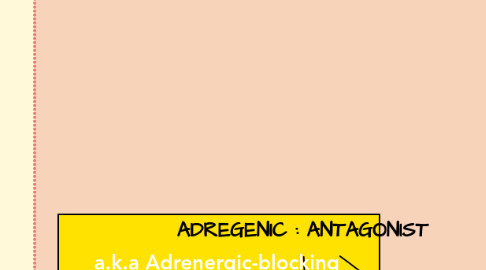
1. a.k.a Adrenergic-blocking agent
2. Type of receptor antagonist
2.1. Alpha receptor
2.1.1. selective alpha-1: prazosin,alfuzosin,terazosin
2.1.1.1. Major Adverse Effect: - Dizziness - Drowsiness - Weakness - Nausea - Palpitation - Edema - First dose phenomenon - urinary incontinence
2.1.1.2. Risk Factor: - upright posture - volume depletion (deficit in ECF volume) - taking BP lowering drug
2.1.1.3. Management: -Start with first dose, take first dose at bedtime
2.1.1.4. Clinical Indication: 1)Hypertension 2)Benign Proplastic Hyperplasia
2.1.1.4.1. 1)With a-1 blocker: PBV relax 2)Without a-1 blocker: PBVConstrict
2.1.1.4.2. 2)Prostate enlargement impair bladder emptying - a-1 receptor mediate prostate bladder contraction - a-1 blocker relaxes the smooth muscle tissue of the bladder and prostate; urine flow improve
2.1.2. selective alpa-2: mirtazipine
2.1.3. non-selective irreversible: phenoxybenzamine (for a-1 and a-2 rcp) -It binds and forms covalent bond with adrenergic rcp -Long duration of action
2.1.3.1. Clinical Indication: - Used to treat hypertension in pheochromocytoma (tumour of adrenal medulla-secretes high amt of cathecolamines , mostly Noradrenaline) -Efficacy in reducing vasoconstriction caused by adrenaline and noradrenaline
2.1.3.2. Adverse Effect: - Nasal congestion - Postural hypotension - Reflex tachycardia
2.2. Beta receptor
2.2.1. selective beta-1: metoprolol,atenolol Selectivity for beta-1 > beta-2 rcp (in lower dose) ' CARDIOSELECTIVE'
2.2.1.1. Clinical Indication: - Beta-1 effect: reduce HR and inotropy - Less Beta-2 effect: less constriction of airways
2.2.2. non-selective: propranolol (equal affinity or non-selective for beta-1 and beta-2)
2.2.2.1. Clinical indication: -Effect of blocking beta-1: reduce HR -Effect of blocking beta-2: constrict airways
2.2.3. intrinsic sympathetic activity: pindolol (non-selective beta-blocker with ISA) , acebutolol (cardioselective beta-blocker with ISA) - capable of exerting low level agonist activity at the beta adrenergenicrcp while simultaneously acting as rcp site antagonist
2.2.3.1. Clinical Indication: Useful in individuals exhibiting excessive bradycardia with sustained beta blocker therapy (eg; patient with congestive heart failure) :
2.2.4. PRECAUTION 1) Care in bronchoconstrictive disease (will block beta-2 rcp in the lung) Beta-1 selective adregenic antagonist may help. 2) Caution in peripheral vascular disease (narrowing of blood vessels at legs,feet,arms.etc. causing cramps/fatigue in legs/buttocks). Blockade of beta-2 rcp causes constriction of peripheral blood vessels eg; cold extremities, 3) Caution in patients with heart conduction defects or anti-arrythmatic drugs - to prevent excessive slowing of heart conduction rate. 4) Withdrawal syndrome: Avoid stopping the drug abruptly. During therapy, beta rcp may increase in number : if drug is stopped , normal cathecolamines release may produce strong sympathetic effects. Stop the drug slowly by tapering the dose down slowly over a few weeks. 5) Caution in diabetes mellitus: LIver cells -> beta-2 rcp at beta cells promote production of glucose from glycogen
2.2.5. CLINICAL INDICATION FOR BETA RECEPTOR ANTAGONIST : - TREAT HYPERTENSION - INHIBIT RELEASE OF RENIN FROM KIDNEY - ANGINA/MYOCARDIAL INFARCTION - CONGESTIVE HEART FAILURE - CARDIAC ARRYTHMIA

